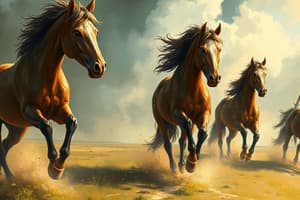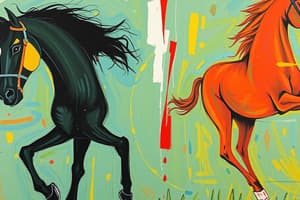Podcast
Questions and Answers
What significance does the image of curtains hold in the context of the poem?
What significance does the image of curtains hold in the context of the poem?
The curtains symbolize people's tendency to hide from troubling realities and avoid confronting the violence around them.
How does Boland's use of the term 'atavism' connect her to her Irish heritage?
How does Boland's use of the term 'atavism' connect her to her Irish heritage?
Atavism connects Boland to her Irish heritage by evoking a sense of ancestral traits and experiences that resonate with Ireland's tumultuous past.
What does the reference to 'burned countryside' suggest about historical conflicts in Ireland?
What does the reference to 'burned countryside' suggest about historical conflicts in Ireland?
The 'burned countryside' symbolizes the devastation and destruction caused by historical conflicts, highlighting the impact of colonialism.
In what way does the imagery of the horse contribute to the theme of potential destruction?
In what way does the imagery of the horse contribute to the theme of potential destruction?
How does the poem challenge readers regarding their roles in society?
How does the poem challenge readers regarding their roles in society?
Flashcards are hidden until you start studying
Study Notes
Overview of 'The War Horse'
- Written in 1975 by Eavan Boland during her time in Dublin.
- A poem capturing the impactful moment of a horse passing by and damaging foliage.
- Explores deeper meanings reflecting the renewed Troubles in Northern Ireland.
- Addresses themes of violence, apathy, and the ravaging effects of war.
Title Significance
- "The War Horse" evokes themes of violence and power associated with battle.
- Suggests a deeper look beyond the innocent appearance of the horse.
Themes and Ideas
- Highlights how ordinary moments can provoke meaningful reflection.
- Considers the nature of violence and societal indifference.
- Explores the destructive consequences of war on both the environment and human life.
Stylistic Elements
- Uses carefully selected auditory and visual imagery to enhance the poem's impact.
- Employs enjambment to mimic the horse's movement.
- Incorporates caesura to allow for reflective pauses.
- Utilizes figurative language, including personification and simile.
- Structured as 30 lines of couplets, emphasizing order within chaos.
Poem Analysis
- Opening Couplets: Sets a calm suburban scene; juxtaposes the ordinary with the unexpected.
- Imagery and Language: Uses strong verbs and onomatopoeia to create vivid visual and auditory images (e.g., "clip, clop, casual").
- Observational Perspective: Boland's passive watching contrasts the horse's freedom with her own confinement.
- Symbolism of the Horse: Represents a transient danger, highlighting the trivial damage done compared to the looming threat of violence.
Reflection on Violence
- Simile of "maimed limb": Connects the triviality of a torn leaf to the gruesome realities of war.
- Personification of Nature: The lost climbing rose symbolizes futures ruined by conflict.
- Existential Inquiry: Reflects on societal indifference to suffering outside personal experience.
Emotional Resonance
- Connection to the Past: Boland's recollection of historical violence evokes atavism and heritage.
- Crisis of Awareness: Challenges readers to confront their complicity in ignoring distant violence.
- Final Reflection: Asks the audience to engage with societal issues rather than hiding behind ignorance or safety.
Conclusion
- 'The War Horse' is not merely an account of a horse passing but a profound commentary on violence, societal apathy, and the lasting impact of war, framed within a personal and relatable narrative.
Studying That Suits You
Use AI to generate personalized quizzes and flashcards to suit your learning preferences.



